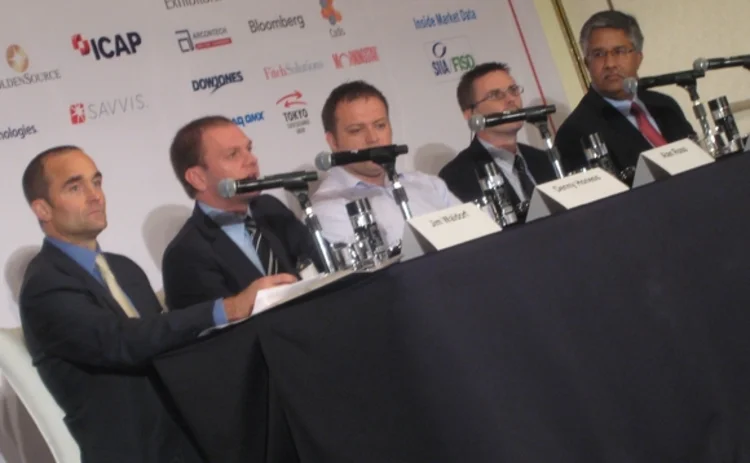Asia-Pacific Financial Information Conference: Asia Weighs Benefits, Costs of Low Latency

Asia-Pacific firms must carefully evaluate the cost of investments in low-latency technologies, since such a small portion of the region supports high-frequency trading, but should consider where these investments can yield other benefits, according to panelists on an FISD panel at the Asia-Pacific Financial Information Conference.
“A focus on latency is unavoidable. But the rate at which people will implement the technologies we see in Europe and the US will be very different,” said Peter Tierney, regional chief operating officer for NYSE Technologies in Asia. Between 2007 and 2009, firms only cared about speed, Tierney says, whereas a second wave of firms buying low-latency infrastructure are more concerned with its ability to deliver cost-effective trading across different regional markets than with latency alone. “The rate at which markets adopt this… will depend a lot on return on investment,” he said.
However, proving ROI is harder in Asia than elsewhere, because to take advantage of proximity to local markets, firms must co-locate in each market center, said Denny Honess, head of global banking and markets dedicated products at Bank of America Merrill Lynch Japan—rather than, say, accessing the majority of US markets from a single co-location center.
“The market here in Asia is completely different to the US or Europe in terms of geographical spread and regulation. And there are only a handful of organizations in the low-latency space,” said Eugen Tjong, head of Enterprise Solutions for real time at Thomson Reuters in Asia-Pacific. “There are exchanges in the region that have invested a lot in co-location space but are 75 percent empty because most of the market is a tier below… and some markets are just not ready. If low latency is your only differentiator from competitors, then you have a problem.”
“Most of us in the region may not have talked about high-frequency trading yet, but we have all spent two or three years getting latency down… to get the best price for clients,” Honess said, adding that latency-reducing technologies such as field-programmable gate arrays (FPGAs) are still largely unknown locally, so anyone looking to deploy them must fully understand them.
However, firms must be free to make decisions in the region that benefit local operations, regardless of a central technology strategy, said Alan Ross, regional head of market data services for Asia-Pacific at UBS. “In any global bank, there’s an amount of strategy that has to be global—that’s how you get firm-wide economies of scale—but then we have to evaluate aspects of specific markets… and the change we’ve seen in the last couple of years is towards managed services and the idea of data as a utility,” Ross said.
Thomson Reuters’ Tjong echoed this, highlighting the importance of making it easier to consume and distribute data. “Data consumption has gone up dramatically over five—or even two—years ago… and pressure on institutions is growing… so there are great opportunities for vendors who can effectively deliver this to users in the right way at the right time,” he said.
Only users who have a paid subscription or are part of a corporate subscription are able to print or copy content.
To access these options, along with all other subscription benefits, please contact info@waterstechnology.com or view our subscription options here: https://subscriptions.waterstechnology.com/subscribe
You are currently unable to print this content. Please contact info@waterstechnology.com to find out more.
You are currently unable to copy this content. Please contact info@waterstechnology.com to find out more.
Copyright Infopro Digital Limited. All rights reserved.
As outlined in our terms and conditions, https://www.infopro-digital.com/terms-and-conditions/subscriptions/ (point 2.4), printing is limited to a single copy.
If you would like to purchase additional rights please email info@waterstechnology.com
Copyright Infopro Digital Limited. All rights reserved.
You may share this content using our article tools. As outlined in our terms and conditions, https://www.infopro-digital.com/terms-and-conditions/subscriptions/ (clause 2.4), an Authorised User may only make one copy of the materials for their own personal use. You must also comply with the restrictions in clause 2.5.
If you would like to purchase additional rights please email info@waterstechnology.com
More on Trading Tech
Robeco tests credit tool built in Bloomberg’s Python platform
This follows the asset manager’s participation in Bloomberg’s Code Crunch hackathon in Singapore, alongside other firms including LGT Investment Bank and university students.
FCA eyes equities tape, OpenAI and Capco team up, prediction markets gain steam, and more
The Waters Cooler: More tokenization, Ediphy lawsuit updates, Rimes teams up with Databricks, and more in this week’s news roundup.
Buy-side data heads push being on ‘right side’ of GenAI
Data heads at Man Group and Systematica Investments explain how GenAI has transformed the quant research process.
Technology alone is not enough for Europe’s T+1 push
Testing will be a key component of a successful implementation. However, the respective taskforces have yet to release more details on the testing schedules.
MayStreet founder says LSEG abandoned integration in new court filing
In response to LSEG’s motion to dismiss a lawsuit filed by the founder of one of its acquired companies, lawyers for Patrick Flannery have offered more details around communications between MayStreet and the exchange group.
As outages spread, it’s time to rethink how we view infrastructure technology
Waters Wrap: First AWS and then Azure. And these are only the most recent of significant outages. Anthony says a change is needed when it comes to calculating server migrations.
LLM firms come for finance, BMLL gets bought, LSEG users get Preqin feeds, and more
The Waters Cooler: Tradeweb completes fully electronic RFM swaptions trade, IBM cashes in on digital asset mania, and more frights and delights in this week’s news roundup.
TMX’s CEO wonders if tokenization is a ‘solution looking for a problem’
While acknowledging the potential of tokenizing securities, John McKenzie said regulators shouldn’t move too fast, and let customer demand drive adoption.








